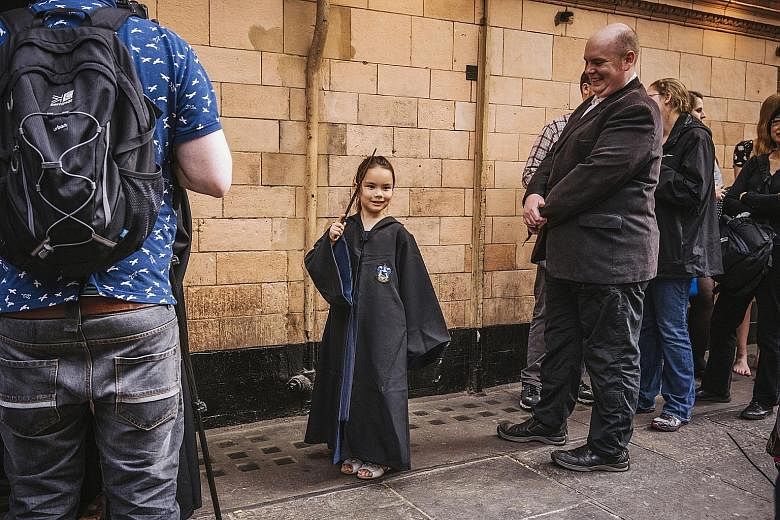LONDON • Oh, for a wizard's spell that would allow me to tell you everything and then erase it completely from your memory.
But though I paid rapt attention during the afternoon and evening I spent at Harry Potter And The Cursed Child, which opened in a blaze of outrageous enchantment on Monday night at the Palace Theatre in London, I failed to pick up on any recipe for inducing post- tell-all amnesia in Muggles, which is Potter-speak for non-wizards like you and me.
This anticipated, two-part, five- hour-plus sequel to J.K. Rowling's best-selling, seven- volume series of Harry Potter novels is the kind of play you want to describe in detail, if only to help you figure out how it achieves what it does.
That would be a kind of magic that is purely theatrical yet somehow channels the addictive narrative grip of Rowling's prose.
Unfortunately, those who have scored tickets to this production, which is sold out till May next year, are given buttons as they leave the theatre that admonish "#KeepThe Secrets". And I do not want to antagonise Potter fans, who tend to be as vigilant and vengeful as the army of Death Eaters that polices the evil empire of He Who Must Not Be Named, aka Lord Voldemort.
Voldemort is now long gone, of course. Or is he?
The story of The Cursed Child - conceived by Rowling with its playwright, Jack Thorne, and director, John Tiffany - makes such questions impossible to answer.
As a character says: "Playing with time - you know we can't do that."
But playing with time, both gleefully and earnestly, is exactly what this show's creators are doing.
Its plot is built on a fantasy that most of us indulge from early childhood: What if we could rewrite our own histories?
The Cursed Child unfolds as a sort of multiple-choice narrative, allowing Potter fans to encounter various might-have-been, might- yet-be paths for characters they already know intimately and for the new ones introduced here.
And, yes, the old gang is back. The first scene of the play is identical to the last one in the final novel, Harry Potter And The Deathly Hallows.
Harry (Jamie Parker, who does Potter pain beautifully), now on the edge of middle age and an employee of the Ministry of Magic, and his wife, Ginny (Poppy Miller), are found at King's Cross railroad station in London, seeing two of their sons - James (Tom Milligan) and Albus (Sam Clemmett) - off to his alma mater, Hogwarts.
Joining Harry and company are his chums, the goofy Ron Weasley (Paul Thornley, delightful) and the perpetual A-student Hermione Granger (Noma Dumezweni), now married and the parents of a Hogwarts- bound girl, Rose (Cherrelle Skeete).
Harry's former archrival, Draco Malfoy (Alex Price), is there too, with his son, Scorpius (Anthony Boyle). Like Albus, Scorpius is a Hogwarts newbie and the two boys seem destined to become best friends.
Who is that cursed child, anyway? More than a few of this story's many, many characters might fit the description.
Like the novels that preceded it, The Cursed Child is stuffed with arcana-filled plots and baldly wrought sentimental life lessons, along with dives into the earnest, tortured solipsism of adolescence.
By right, such a combination should try the patience of any grown-up. But like Rowling's books, the play vanquishes resistance.
I reread The Deathly Hallows on the flight to London from New York and I was amazed at how naturally what I saw on the stage seemed to flow from the page.
Thorne, Tiffany and their movement director, Steven Hoggett, and set designer, Christine Jones, collaborated previously on the chilling adolescent vampire play, Let The Right One In, and they are all expert in mapping the intersection of the uncanny and the everyday.
A convocation of wizards is evoked through the simultaneous swirling of black capes; an otherworldly, xenophobic and unsettlingly topical-feeling fascist brigade materialises and multiplies out of yawning darkness; and staircases and suitcases assume varied lives that propel both themes and story.
This production captures Rowling's sensibility even more persuasively than did the special effects-driven films.
True, the movies were blessed with an unmatchable stable of British character actors such as Alan Rickman and Maggie Smith. But in The Cursed Child, everyone onstage has direct, present-tense responsibility for the story being told.
Suffice it to say that these transformations become haunting, funny physical reflections of our desire to connect with the people we only think we know well, with the dead who linger in our lives and with the selves we once were and will be.
The word for these imaginative leaps of faith is empathy. That's the magic practised so affectingly and entertainingly in The Cursed Child and it turns everyone in the audience into a sorcerer's apprentice.
NEW YORK TIMES

